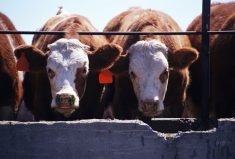Despair is the price one pays for setting an impossible aim. Given the phone calls over the past week, producers have been expecting something the market cannot offer.
Western Canadian feeder cattle prices were under severe pressure, with 700-plus-pound cattle down $8-$12 from seven days earlier; calves under 700 lbs. traded $4-$8 below week-ago levels. Heavier feeders led the market lower, as dressed bids from Alberta packers fell $10-$15. In contradistinction to last year, waiting is an option, because auction market volumes are at seasonal highs and prices are trending lower. We are at the peak of the fall run and feedlots have sufficient numbers for the time being. Negative feeding margins are not turning around anytime soon and rationale is setting in on additional purchases.
Read Also

U.S. grains: Soybeans hit six-week low as Brazilian harvest looms; corn, wheat sag
Chicago | Reuters – Chicago soybean futures fell to six-week lows on Friday as worries about slowing export demand for…
In east-central Alberta, mixed steers averaging 760 lbs. sold for $242, which was a bright spot on the week. Other auction markets in central Alberta quoted similar-weight cattle around 750 lbs. trading from $225 to $235. Mixed Angus-based larger medium-frame steer calves averaging 500 lbs. were quoted at $278 landed in southern Alberta. Eastern Prairie markets continue to trade at a sharp premium over Alberta, especially on the lighter calves. Larger-frame higher-quality steers weighing just over 500 lbs. sold for $290-$295 in southeastern Saskatchewan. The weaker Canadian dollar, along with plentiful forage supplies, continues to support prices in Manitoba and eastern Saskatchewan. U.S. buyers appear to have a greater risk tolerance.
Wholesale beef prices were softer this week, and packers are well covered for their nearby requirements. The futures market continues to factor in a year-over-year beef production increase of nearly 600 million lbs. during the second quarter of 2016, which is also weighing on nearby prices. Pork values are searching for a bottom and the focus is turning to poultry and turkey over the next couple of weeks. Beef consumption usually increases in December, but with beef stocks overflowing in cold storage, it’s difficult to justify a sustainable rally in cattle prices.
— Jerry Klassen is manager of the Canadian office for Swiss-based grain trader GAP SA Grains and Produits. He is also president and founder of Resilient Capital, which specializes in proprietary commodity futures trading and commodity market analysis. Jerry owns farmland in Manitoba and Saskatchewan but grew up on a mixed farm/feedlot operation in southern Alberta, which keeps him close to the grassroots level of grain and cattle production. Jerry is a graduate of the University of Alberta. He can be reached at 204-504-8339.
















